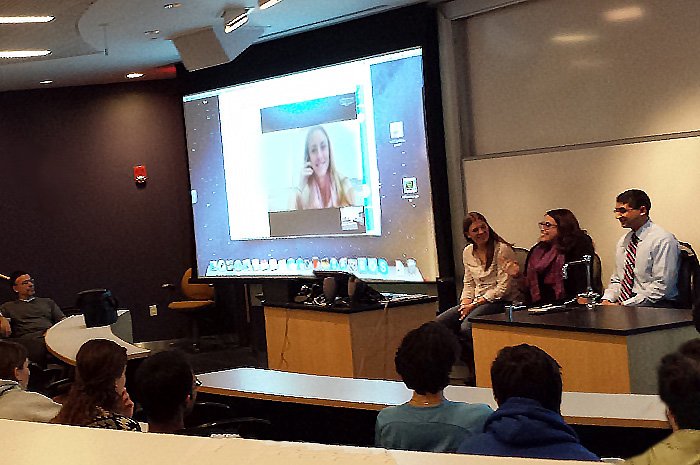Blinding Them With Science

Emily Swain '10 chats about her experiences as a science teacher during a career-discussion event with Allison Hall '11 (seated, far left) and Adnan Solaiman '10 (seated, far right). Katie McCann '11 (onscreen) weighed in on the conversation via Skype.
Young alumni discuss their paths to science careers
by MaryAlice Bitts-Jackson

Emily Swain '10 chats about her experiences as a science teacher during a career-discussion event with Allison Hall '10 (seated, far left) and Adnan Solaiman '10 (seated, far right). Katie McCann '11 (onscreen) weighed in on the conversation via Skype.
What can you do with a Dickinson science degree? Plenty, say four recent grads who returned to their alma mater to chat with current students about their newly launched science careers.
Adnan Solaiman ’10, an international student from Pakistan who majored in biochemistry & molecular biology and earned a health-studies certificate, knew he was interested in science when he arrived at Dickinson, but like most first-years, he was unsure of what, precisely, he wanted to do. He soon joined the college’s Pre-Health Society, and, after volunteering in a local hospital’s emergency room during his sophomore year, his goals came into view.
Delving deeper, Solaiman took part in a student-faculty cancer-research project with Associate Professor of Biology Mike Roberts and Assistant Professor of Mathematics Jeff Forrester; he also attended a two-week, intensive summer program at the Penn State Hershey College of Medicine. Today, this young alum is in his final year of medical school at Penn State Hershey; he’s busily applying for residency training in physical medicine and rehabilitation, a field that combines his interest in neurology, orthopedics and sports medicine.
Asked to offer advice to those the beginning of the exploratory stage, Solaiman encouraged students to seek advice from professors and Career Center staff and look for opportunities to shadow professionals in their fields of interest, as he did at hospitals in Carlisle and Hershey. “If you have a chance [to do student-faculty research], I highly recommend it,” he added. “That was one of the most meaningful things I did at Dickinson, because it really gave me an appreciation for research and the scientific process.”
Emily Swain ’10 (biochemistry & molecular biology) also had an eye on medical school as an undergraduate, though she eventually took a different route. Her search began with an internship at a pharmaceutical company (“Hated it!”), followed by a student-researcher stint with Solaiman, Roberts and Forrester—a decidedly more enjoyable experience, but not quite as people-oriented as she would have liked.
At Roberts’ advice, Swain applied to Teach for America, a program for top college graduates and professionals who commit to teach for two years in high-need communities. “I didn’t think I’d like teaching, but I ended up loving it,” said Swain, now a science teacher at Chavez Preparatory School in Washington, D.C., who has helped coach beginning Teach for America educators. “I’m challenged, in the best ways, every day.”
Her advice to fellow science-minded Dickinsonians: “You’re probably here, at a liberal-arts school, because you’re interested in a lot of things, so stay open-minded,” she said, noting that according to some social scientists, students can expect to change career courses four times during their professional lives. “There will be career opportunities, years from now, that don’t even exist yet.”
Katelyn “Katie” McCann ’11 (biology) interned as a research technician as an undergrad and began her current job as a research coordinator at Boston Children’s Hospital in August 2011. That on-the-job experience helped crystallize her long-range plans.
“It’s the best possible work scenario for me, because I am interested in medicine and research, and it’s allowed me to do both,” said McCann, who interacts closely with patients while studying gastrointestinal illness and immunology. “I decided that I wanted to pursue a career that’s 80 percent research and 20 percent clinical.”
Last year, McCann began her work in the University of Massachusetts M.D./Ph.D program—an eight-year undertaking that interweaves lab work with medical-school studies. Speaking to the audience of approximately 60 students via Skype, she offered this advice: “You shouldn’t feel like you need to rush into the next steps. If there’s something you’re interested in, try it out and really get a good sense of it.”
Allison Hall ’10 (biology) worked as a lab coordinator in Washington, D.C., for two years after graduation, a position that allowed her to teach—which she enjoyed—and to research. She’s now in her third year in the molecular-biology graduate program at Princeton University and looks forward to earning her Ph.D.
“It feels a lot like Dickinson at Princeton—there is a lot of good interaction with faculty,” she said, “and there are a lot of Dickinson alumni in the program.”
Like Solaiman, Hall urged students to tap faculty and staff expertise and seize student-faculty research opportunities. “You have a lot of resources here—use them,” she said, adding that while most undergraduates who perform research work as lab techs, Dickinson students “have to learn and think about what you are doing. You are much better prepared to think on your own.”
Asked to describe her postdoctoral plans, Hall saw an opening for a joke. "The average time it takes to finish this program is about five years, and hopefully by then, Mike [Roberts] will retire,” she said with a nod toward her former advisor, “and I’ll take his job.”
“Just let me know when you’re ready,” the professor responded dryly—but with a grin.
Learn more
- Career Center
- Academic Programs
- “Synergistic Discoveries”
- Focus on Faculty: Mike Roberts
- Alumni in Action
- Latest News
Published October 20, 2014